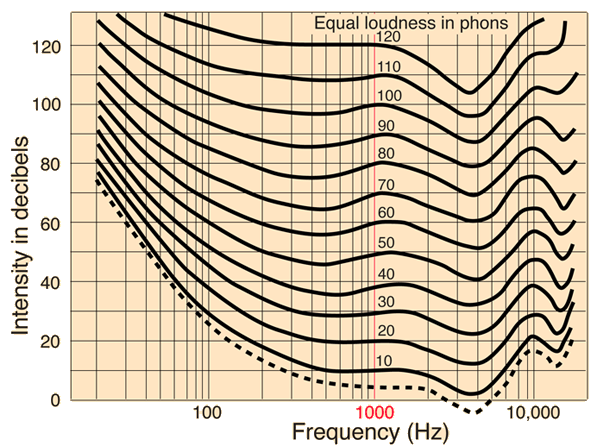Ever wondered why pink noise or some form of band-pass noise is used for measuring and calibrating speaker levels in the all-critical midrange?
I did once, and a very simple test can demonstrate the problem with using sine waves for speaker level adjustments.
Play a sine wave tone through one speaker at the single most critical, and sensitive, frequency to human hearing, 3.7kHz (see the equal loudness curve below). It doesn't need to be terribly loud, but just play that sine wave through a speaker. Then go sit down and plug one ear so the other ear appears to be the alone in being able to hear the tone. Now, very slowly move you head around, side to side, nod, dip, move that ear through as much as a foot of space and see what you hear.
If you do the experiment, you know what you heard - the volume of the test tone would shift from being loud and clear to being darn near inaudible as you moved your head around. This is from reflections in the room. Even a properly tuned room with excellent acoustic treatments will experience this phenomena.
Basically, the acoustic energy will reflect off the walls, many times over, and hit your ear either in phase with the speaker's original, first contact sound source, or it will be slightly out of phase, or it could potentially be completely out of phase. And, we all know what happens when two signals of similar amplitude reach your ears at different times - the time delay cause lots of phase issues for steady state waveforms, like a sine wave, and either amplify the energy (in phase) or nullify the energy (out of phase) or something in between. Since there are dozens, or even hundreds of reflections reaching your ear with different amounts of delay, and thus phase shift, the acoustic energy level at your eardrum will vary from being louder than the source to being completely silent.
CRAZY, EH?
With pink noise, or some other random noise, the number of tones being impacted by phase issues from reflections is insanely huge (well, there are 1,000 frequencies from 2,000Hz and 2,999Hz) each with different amounts of phase shift per any unit of distance, making our perception of the sound to be more balances.
With bass, there are fewer potential frequencies and the difference in the room between 44Hz and 45Hz isn't very much (whereas the difference between 3,055Hz and 3,060Hz is quite large in terms of phase shift per unit of distance).
So... use pink noise for general level setting of main, fullrange, or position channel speakers. Noise for bass calibration is more difficult, because random noise gets floppy with bass given the fewer frequencies and the time between nodes for any given tone below 100Hz.


I did once, and a very simple test can demonstrate the problem with using sine waves for speaker level adjustments.
Play a sine wave tone through one speaker at the single most critical, and sensitive, frequency to human hearing, 3.7kHz (see the equal loudness curve below). It doesn't need to be terribly loud, but just play that sine wave through a speaker. Then go sit down and plug one ear so the other ear appears to be the alone in being able to hear the tone. Now, very slowly move you head around, side to side, nod, dip, move that ear through as much as a foot of space and see what you hear.
If you do the experiment, you know what you heard - the volume of the test tone would shift from being loud and clear to being darn near inaudible as you moved your head around. This is from reflections in the room. Even a properly tuned room with excellent acoustic treatments will experience this phenomena.
Basically, the acoustic energy will reflect off the walls, many times over, and hit your ear either in phase with the speaker's original, first contact sound source, or it will be slightly out of phase, or it could potentially be completely out of phase. And, we all know what happens when two signals of similar amplitude reach your ears at different times - the time delay cause lots of phase issues for steady state waveforms, like a sine wave, and either amplify the energy (in phase) or nullify the energy (out of phase) or something in between. Since there are dozens, or even hundreds of reflections reaching your ear with different amounts of delay, and thus phase shift, the acoustic energy level at your eardrum will vary from being louder than the source to being completely silent.
CRAZY, EH?
With pink noise, or some other random noise, the number of tones being impacted by phase issues from reflections is insanely huge (well, there are 1,000 frequencies from 2,000Hz and 2,999Hz) each with different amounts of phase shift per any unit of distance, making our perception of the sound to be more balances.
With bass, there are fewer potential frequencies and the difference in the room between 44Hz and 45Hz isn't very much (whereas the difference between 3,055Hz and 3,060Hz is quite large in terms of phase shift per unit of distance).
So... use pink noise for general level setting of main, fullrange, or position channel speakers. Noise for bass calibration is more difficult, because random noise gets floppy with bass given the fewer frequencies and the time between nodes for any given tone below 100Hz.


